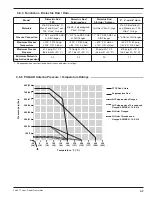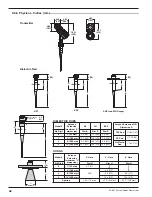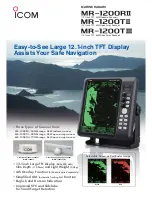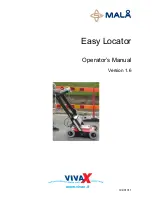
43
58-601 Pulsar
®
Radar Transmitter
Four Wire
An electronic instrument design that uses one set of
wires to supply power (120/240 VAC, 24 VDC) and another set
to carry the process measurement signal (4–20 mA). Also called
Line Powered.
FSK
Frequency Shift Keying
See HART.
Gain
Amplification adjustment to attain optimum performance
in various product dielectric ranges. (Factory setting).
Ground
An electrical connection to the Earth’s potential that is
used as a reference for the system and electrical safety.
Grounded
A state where no electrical potential exists between
the ground (green) connection on the transmitter and the Earth
or system ground.
Guided Wave Radar
See TDR.
HART
Highway Addressable Remote Transducer
Protocol that
uses the Bell 202 frequency shift keying (FSK) method to super-
impose low level frequencies (1200/2000 Hz) on top of the stan-
dard 4–20 mA loop to provide digital communication.
HART ID
See Poll Address.
Hazardous Area
An area where flammable gases or vapors are or
may be present in the air in quantities sufficient to produce
explosive or ignitable mixtures.
Horn Antenna
A metallic, cone transition between the
microwave waveguide and air.
IEC
International Electrotechnical Commission
Organization that
sets international standards for electrical devices.
Increased Safety
Designs and procedures that minimize sparks,
arcs, and excessive temperatures in hazardous areas. Defined by
the IEC as Zone 1 environments (Ex e).
Information (message)
The lowest level in the hierarchy of
diagnostic conditions providing operational factors that are not
critical to measurement. Further information can be obtained by
viewing the Status or Diagnostic (Factory Menu) screens.
Intrinsically Safe Ground
A very low resistance connecting to a
ground, in accordance with the National Electrical Code (NEC,
ANSI/NFPA 70 for FMRC), the Canadian Electrical Code
(CEC for CSA), or the local inspector.
Intrinsic Safety
A design or installation approach that limits the
amount of energy that enters a hazardous area to eliminate the
potential of creating an ignition source.
Level
The present reading of the height of material in a vessel;
compliment of Distance.
LevlOfst
Level Offset
The distance above the tank bottom where
radar level measurement is impossible due to heating coils, baf-
fles, angled or curved tank bottoms, etc. The mA output will
never read lower than the Level Offset value.
Linearity
The worst case error calculated as a deviation from a
perfect straight line drawn between two calibration points.
Line Powered
See Four Wire.
LOE
Loss of Echo
Condition where a level measurement is
impossible due to the absence of valid reflections from the liquid
surface.
LOE Delay
Loss of Echo Delay
The amount of time the trans-
mitter spends looking for a valid Level signal before going into
Loss of Echo Fault The last valid Level reading is held during
this search.
LOE Fault
Loss of Echo Fault
The mA value to which the output
is driven after the Loss of Echo Delay times out; choices are
3.6mA, 22mA and HOLD.
Loop
The present reading of the 4–20 mA current output.
Loop Powered
See Two Wire.
Loop Tst
Loop Test
Built-in system capability to test/calibrate a
loop (or separate loop device) by driving the transmitter output
to a particular value.
Low Voltage Directive
A European Community requirement for
electrical safety and related issues of devices using 50-1000 VDC
or 75–1500 VAC.
Measured Value
The typical level measurement values used to
track the level of a process: Level, % Output, and Loop.
Media
The liquid material being measured by the level trans-
mitter.
Multidrop
The ability to install, wire, or communicate with
multiple devices over one cable. Each device is given a unique
address and ID.
Non-hazardous Area
An area where no volatile mixtures of
vapors/gas and oxygen will be found at any time. Also called
General Purpose Area.
Non-Incendive
A circuit in which any arc or thermal effect pro-
duced, under intended operating conditions of the equipment or
due to opening, shorting, or grounding of field wiring, is inca-
pable, under specific test conditions, of igniting the flammable
gas, vapor, or dust-air mixture.
Password
A numerical value between 0 and 255 that protects
stored configuration data from unauthorized manipulation.
Percent (%) Output
The present reading as a fraction of the
16 mA scale (4–20 mA).
Poll Address (HART ID)
A number between 1 and 15 which
sets an address or location of a device in a multi-drop loop. Poll
address for single device configuration is 0.
Qual
Quality
A relative value (0–99) that shows the strength
and usefulness for a given reflected signal.
QuickStart
The essential information needed for the PULSAR
radar transmitter and antenna to be installed, wired, and calibrated.
Radar (Radio Detection And Ranging)
Uses EM energy and
high speed timing circuits to determine distance. Original Radar
devices used energy in the radio frequency range (MHz), many
current devices use much higher frequencies (GHz).






































